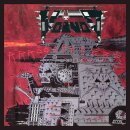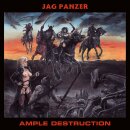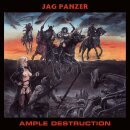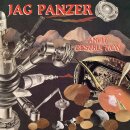High Roller Records, 40th anniversary edition, new cover art, black double vinyl, ltd 300, original + remix version, 7mm spine 425gsm heavy cardboard cover, A1 tour poster, lyric sheet, 8 page booklet
Remix Version: Mastering and audio restoration by Patrick W. Engel at TEMPLE OF DISHARMONY in 2013.
Original Mix Version: Mastering and audio restoration by Patrick W. Engel at TEMPLE OF DISHARMONY in 2020.
LP1 (original mix 1984) + LP2 (re-mix 1989):
01 Licensed to Kill
02 Warfare
03 Symphony of Terror
04 Harder than Steel
05 Generally Hostile
06 The Watching
07 Reign of the Tyrants
08 Cardiac Arrest
09 The Crucifix
10 Interlude
11 Black Sunday (bonus track)
The history of a metal classic: AMPLE DESTRUCTION – Versions 1.0 and 2.0 Through the years the 1984 debut album of JAG PANZER was reissued many times - with official and unofficial versions. The original LP was released by AZRA/Iron Works who also did the Jag Panzer EP in 1983. Collectors already know that this label was not just offering a LP and maybe an additional single, but tons of various shape discs and specials, most in small quantities. AZRA/Iron Works got kind of famous for that in the metal scene. The secret behind this form of marketing is that the owner, David Richards, was able to produce all those shapes in his basement. A nightmare for collectors today… Not many fans know about the two different mixes of AMPLE DESTRUCTION. So it´s time to talk with Mark Briody. About less known facts and nerdy details. Please let us know about the recording studio. Was it 24-track? And how do you remember the other equipment? “It was a Tascam 16 track tape deck. He also had a Tascam board. For reverb he had an actual plate reverb, it was this huge big metal plate by the wall. He had SM57 and SM58 microphones. We rented a few high end microphones for cymbal overheads.“ How many days did you spent recording the album? “ It was 8 or 9 days, but they weren’t full days. The studio was pretty busy back then since it was the best studio in town. So we got in whenever we could for a few hours.“ Were parts of the LP recorded live? Did you use any form of clicktrack back then? “Rhythm tracks were live, but my rhythm guitar parts didn’t come out so great (sound quality), so I re-cut most of them. The drums were in the main room, Joey’s amp in the vocal booth, John’s bass amp in the bathroom (with lots of cardboard boxes to damped the sound). My amp was placed in the stairway entry to the studio. There was a weird echo and tone with my rhythms, but we kept those tracks and I did another version of them with my amp in the vocal booth. There was no click track, however the songs I wrote were always to a tempo and Rick (drummer) and I had both played for years in school jazz band where we did play to a metronome. We were pretty good about keeping time.“ „Black Sunday“ was not a part of the original album. Was it recorded in the same session? And what were the plans for that track? „It was recorded in the same sessions but always intended to be a bonus track. Back then everyone told us that we should always have a bonus track. Looking back I wished we spent the time on the mix and not recording an extra song.“ The album was released with what we now call „the original mix“ or „the first mix“. Compared to many other LPs on independent labels, it was already offering a good and powerful sound. So what was leading to the remix and when and where did it happen? „We had no time for the original mix. Maybe 1 ½ hours to 2 hours for the whole album. Considering the time it takes to assemble a master we only had maybe 5 minutes each song to mix. So basically the sound was the mix we had been tracking to. I think Tom did an amazing job on the mix, but there is only so much you can do with that short of time to mix.“ What was the first version with the new remix? “Part of the Metal Blade reissue deal was that they paid for 2 days to remix. So instead of 2 hours to mix we now had 16 hours. The studio still owned the same tape deck and board, but much better outboard gear. The remix sounds like the mix we had hoped for originally. I’m not saying the original is terrible, I’m proud of it, but the remix is so much clearer and has more punch.“ One of the general differences I am noticing between that first mix and the remix from 1989 is that the original mix appears „less direct“. Also the drums are not as powerful and noticable than on the remix. “ The better outboard effects (nice compressor for example) made a big difference. We didn’t have great gear to begin with. Joey, John and I each only owned 1 guitar and 1 amp. Rick’s kit was just a basic drumkit. The tracks were well recorded though, so they really benefited from better EQ, compression, reverb, etc.“ When listening to „The Crucifix“, the whole song seems to be drowned in delay, while the remix is again more direct sounding… “ That’s my fault. I thought the song called for lots of atmosphere. I asked for more delay. I have asked for big delay, but turned down in the mix. I just didn’t know, I didn’t have the experience. Thankfully we fixed it in the remix.“ When comparing the drum opening of „Generally Hostile“ you can notice that the bassdrums on the original sound very different. The bassfrequencies are missing here. On the remix the sound of the bassdrums is more full. “We worked a lot on the drums with the remix. I like to spent time on drums, but on the original mix it was zero time spent. Most of the time on the original mix was balancing backing vocals. The drums, bass and guitar were just left as they were. Again I’d like to say – for the time spent Tom did an amazing job on that first mix.“ Both mixes of „Reign Of The Tyrants“ have a fade-in, but not completely. The song just starts with a lower volume. What was the reason for this decision? “Honestly I can’t tell you. I never liked the fade in personally so I wasn’t paying much attention. Everything in Jag Panzer is split with everyone’s opinions being equal. I got outvoted on that one. *lol*.“ The first seconds of „Cardiac Arrest“ sound nearly mono on the original mix. This is changing when more rhythm guitars set in. Another thing that was changed (or fixed?) on the remix. How many guitar tracks did you record on this album? “It probably was almost mono on the original. We did at most 5 guitar tracks (2 rhythm, 2 lead and my extra re-recorded rhythm). The intro to that would have been on the lead tracks so that were probably panned almost center.“ There were many official and unofficial reissues of Ample Destruction through the years. Did you notice if any of them was offering that first mix? “ All of them used the first mix until the Metal Blade release came out. Everything after that (all official releases) used the Metal Blade mix. High Roller had Patrick W. Engel re-master everything from the Metal Blade remix. Patrick is amazing, he did a great job!“ Imagine a third mix would be possible today. Is there anything you would change? Maybe for an alternative remix-version in addition to the original(s). “I wouldn’t change anything. The original and Metal Blade mix were the same tape deck, same studio and same engineer. That keeps the spirit of the album for me! I’m sure someone else could get a great sound with a full remix, but that’s not something that would interest me. Perhaps it would interest fans, but not me personally.“
Neudi, April 2021
| Item weight: | 0,75 kg |
Manufacturer:
Name: High Roller Records
Address: Bertolt-Brecht-Str. 1a, 08412 Werdau, Germany
E-Mail: info@hrrshop.de









